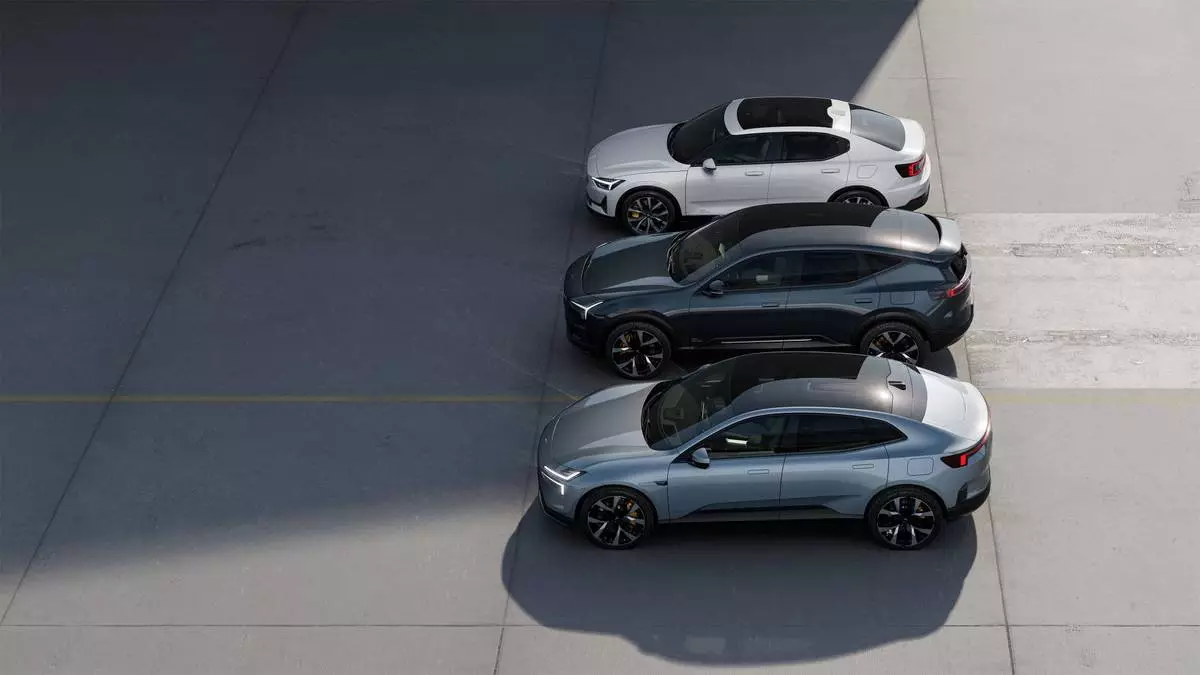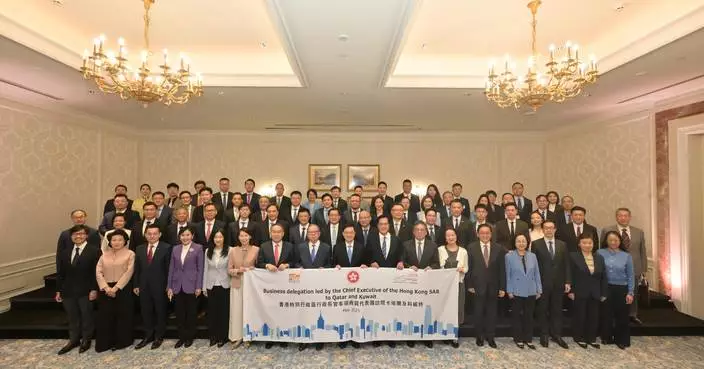DES MOINES, Iowa (AP) — A 30-year-old community service program that sends young adults to work on projects across the U.S. was the latest target of the Trump administration 's campaign to slash government spending.
AmeriCorps’ National Civilian Community Corps informed volunteers Tuesday that they would exit the program early “due to programmatic circumstances beyond your control,” according to an email obtained by The Associated Press.
The unsigned memo to corps members said NCCC’s “ability to sustain program operations” was impacted by the Trump administration’s priorities and President Donald Trump’s executive order creating the Department of Government Efficiency. Members would be officially dismissed April 30.
AmeriCorps did not respond Wednesday to an AP email seeking comment.
AmeriCorps NCCC, which completed its 30th year last year, employs more than 2,000 people ages 18 to 26 participating for a roughly 10-month service term, according to the program’s website. The teams of corps members are tasked with working on several projects related to education, housing, urban and rural development, land conservation, and disaster relief, driving from one assignment to another across the country.
The agency pays for volunteers' basic expenses, including housing, meals and a “limited health benefit,” as well as a “modest” living allowance, according to the program. The program also provided members who complete their 1,700-hour service term with funding for future education expenses or to apply to certain student loans. That benefit was worth about $7,300 this service year.
Funding for AmeriCorps and NCCC has long been scrutinized when Congress talks of budget trims. The federal agency’s budget showed NCCC funding amounted to nearly $38 million last fiscal year.
A White House official said the Trump administration questioned using taxpayer money for the program. The official spoke on condition of anonymity because they were not authorized to comment publicly.
The traditional NCCC volunteers worked with sponsors including community and faith-based based organizations, nonprofits, schools, cities and tribes. Some of the recent service projects included working at a food bank in Washington state, building homes with Habitat for Humanity in North Carolina, and facilitating after school programs in Arizona.
AmeriCorps NCCC also has a partnership with the Federal Emergency Management Agency and, more recently, the U.S. Forest Service. Those volunteers over the last year responded to tornadoes and flooding in Iowa, hurricane damage in North Carolina and wildfires in California, among other natural disasters, when volunteers are especially visible.
Young corps members were told Tuesday night to pack up. Many started long road trips from their latest assignment to campuses in Vicksburg, Mississippi; Vinton, Iowa; Sacramento, California; and Aurora, Colorado. Members would receive their allowance and health coverage through the end of April, according to the memo.
Members were told in the memo that those who have completed 15% or more of their term would be eligible for a prorated amount of their education award.
But Kate Raftery, who was NCCC director from 2011 to 2014, said she's worried about the corps members, many of whom were the “unusual suspects” who “saw this as a really impactful education or career launching pad.”
“They were not young people who had been striving to be service members somewhere,” Raftery said. “They were looking for an opportunity to improve their life. They were looking for an opportunity to build some skills, and to be part of a community.”

FILE - As President Barack Obama and former President Bill Clinton mark the 20th anniversary of the AmeriCorps national service program, hundreds of new volunteers are sworn in for duty at a ceremony, Friday, Sept. 12, 2014, on the South Lawn of the White House in Washington. (AP Photo/J. Scott Applewhite, file)
GOTHENBURG, Sweden--(BUSINESS WIRE)--May 12, 2025--
Polestar (Nasdaq: PSNY) reports select financial and operational results for the quarter ended March 31, 2025 (Q1 2025).
This press release features multimedia. View the full release here: https://www.businesswire.com/news/home/20250512313129/en/
Michael Lohscheller, Polestar CEO, said: “We continue to make great progress, transforming our commercial operations and taking steps to reduce our cost base. We are selling more cars, at improved margins, resulting in revenue growth of 84%, a gross margin that is now positive, at 7%, and a narrowing net loss. We have a strong and growing line-up of attractive cars, with an expanding network of retail partners across key markets. The geopolitical environment and market conditions are challenging, but we are on the right track and doing the right things.”
Key financial highlights
Preliminary key operational highlights
The table below summarizes key preliminary operational highlights as of and for the three months ended March 31, 2025:
Key loan facilities and funding highlights
As previously announced regarding the Company’s USD 950 million ‘club loan’, the lenders agreed to amend the revenue covenant for 2024 to ensure its compliance and also agreed to waive testing of the year-end 2024 and Q1 2025 debt-to-asset ratio covenant. The Company is continuing to have a constructive dialogue with lenders regarding its future club loan obligations.
We continue to work closely with Geely Group on securing new equity and debt funding.
The Company is still at an acceptable debt level in relation to its loan covenants.
Key recent developments
Key business and operational highlights
Unaudited reconciliation of GAAP and Non-GAAP measures
Conference call
Michael Lohscheller, CEO, and Jean-Francois Mady, CFO, will host a conference call today, 12 May 2025, at 14:00 CET. To join the call, please follow the instructions available under Events on the Polestar Investor Relations website.
Notes
All financial figures are in millions of U.S. dollars (USD). Unless stated otherwise, the performance shown in this press release covers the three-month period ended 31 March 2025 (Q1 2025), compared to the three-month period ended 31 March 2024 (Q1 2024).
Calendar
Polestar expects to report its retail sales volumes for Q2 2025 on 10 July 2025.
Polestar Automotive Holding UK PLC
Polestar uses both generally accepted accounting principles (“GAAP,” i.e., IFRS) and non-GAAP (i.e., non-IFRS) financial measures to evaluate operating performance and for other strategic and financial decision-making purposes. Polestar believes non-GAAP financial measures are helpful to investors as they provide useful perspective on underlying business trends and assist in period-on-period comparisons. These measures also improve the ability of management and investors to assess and compare the financial performance and position of Polestar with those of other companies.
These non-GAAP measures are presented for supplemental information purposes only and should not be considered a substitute for financial information presented in accordance with GAAP. The measures are not presented under a comprehensive set of accounting rules and, therefore, should only be read in conjunction with financial information reported under GAAP when assessing Polestar's operating performance.
The measures may not be the same as similarly titled measures used by other companies due to possible differences in calculation methods and items or events being adjusted. A reconciliation between non-GAAP financial measures and the most comparable GAAP performance measures is provided below.
The non-GAAP financial measures used in this press release are Adjusted EBITDA and Free Cash Flow:
Adjusted EBITDA
Adjusted EBITDA is calculated as net loss, adjusted to exclude listing expense, fair value change - Earn-out rights, fair value change - Class C Shares, finance expense, finance income, income tax benefit (expense), depreciation and amortization, impairment of property, plant and equipment, vehicles under operating leases, and intangibles assets, restructuring costs, disposals of investments, and unusual operating income and expenses that are considered rare or discrete events and are infrequent in nature. Depreciation and amortization includes (1) depreciation and amortization capitalized into the carrying value of inventory sold (i.e., part of inventory costs) and (2) depreciation and amortization expense. Restructuring costs include expenses associated with programs that were planned and controlled by management, and materially changed either (1) the scope of a business undertaken by the Group or (2) the manner in which business is conducted. Disposals of investments include disposals of, by sales or otherwise, (1) debt or equity financial instruments issued by another entity that are held as investments, (2) intangible assets, (3) property, plant, and equipment, and (4) groups of assets and liabilities representing disposal groups that were transferred together as part of individual transactions.
This measure is reviewed by management and management considers it to be a relevant measure for understanding the underlying operating results and trends of the core business prior to the impact of any adjusting items.
Prior to December 2024, Adjusted EBITDA was calculated as net loss, adjusted for listing expense, fair value change - Earn-out rights, fair value change - Class C Shares, interest income, interest expense, income tax benefit (expense), depreciation and amortization, and the impairment of property, plant and equipment, vehicles under operating leases, and intangibles assets.
The calculation was refined during December 2024 to change interest income and interest expense to finance income and finance expense, respectively, in order to exclude the effects of all items associated with financing activities of the Group instead of only interest related items. Additionally, exclusions for restructuring costs, disposals of investments, and unusual other operating income and expenses that are considered rare or discrete events and are infrequent in nature were added to the calculation to further refine management's view of earnings from core operations. The definition of depreciation and amortization was also changed to include depreciation and amortization capitalized into the carrying value of inventory sold (i.e., part of inventory costs) to account for the Group's change in the pattern of consumption of the future economic benefits embodied in internally developed and acquired intellectual property for the Polestar 2 from the straight-line method to units of production method in the fourth quarter of the year ended December 31, 2023. This method is also applicable to internally developed and acquired intellectual property for the Polestar 4, which entered production in the fourth quarter of the year ended December 31, 2023 and the Polestar 3, which entered production in the first quarter of the year ended December 31, 2024. The change to the definition of depreciation and amortization clarifies that the impact of all depreciation and amortization, irrespective of methodology and expense nature, is excluded from net loss for this measure. These changes provide a clearer view of earnings from core operations from management's perspective and improve comparability of earnings from core operations across reporting periods. Accordingly, Adjusted EBITDA for the comparative period is recast for the new calculation and presented alongside the historical calculation for comparability.
Statement regarding unaudited financial and operational results
The unaudited financial and operational information published in this press release is subject to potential adjustments. Potential adjustments to operational and consolidated financial information may be identified from work performed during Polestar’s year-end audit. This could result in differences from the unaudited operational and financial information published herein. For the avoidance of doubt, the unaudited operational and financial information published in this press release should not be considered a substitute for the financial information filed with the SEC in Polestar’s Annual Reports on Form 20-F.
About Polestar
Polestar (Nasdaq: PSNY) is the Swedish electric performance car brand with a focus on uncompromised design and innovation, and the ambition to accelerate the change towards a sustainable future. Headquartered in Gothenburg, Sweden, its cars are available in 27 markets globally across North America, Europe and Asia Pacific.
Polestar has three models in its line-up: Polestar 2, Polestar 3, and Polestar 4. Planned models include the Polestar 5 four-door GT (to be introduced in 2025), the Polestar 6 roadster and the Polestar 7 compact SUV. With its vehicles currently manufactured on two continents, North America and Asia, Polestar plans to diversify its manufacturing footprint further, with production of Polestar 7 planned in Europe.
Polestar has an unwavering commitment to sustainability and has set an ambitious roadmap to reach its climate targets: halve greenhouse gas emissions by 2030 per-vehicle-sold and become climate-neutral across its value chain by 2040. Polestar’s comprehensive sustainability strategy covers the four areas of Climate, Transparency, Circularity, and Inclusion.
Forward-looking statements
Certain statements in this press release (“Press Release”) may be considered “forward-looking statements” as defined in the Private Securities Litigation Reform Act of 1995. Forward-looking statements generally relate to future events or the future financial or operating performance of Polestar including the number of vehicle deliveries and gross margin. For example, projections of revenue, volumes, margins, cash flow break-even and other financial or operating metrics and statements regarding expectations of future needs for funding and plans related thereto are forward-looking statements. In some cases, you can identify forward-looking statements by terminology such as “may”, “should”, “expect”, “intend”, “will”, “estimate”, “anticipate”, “believe”, “predict”, “potential”, “forecast”, “plan”, “seek”, “future”, “propose” or “continue”, or the negatives of these terms or variations of them or similar terminology. Such forward-looking statements are subject to risks, uncertainties, and other factors which could cause actual results to differ materially from those expressed or implied by such forward looking statements.
These forward-looking statements are based upon estimates and assumptions that, while considered reasonable by Polestar and its management, as the case may be, are inherently uncertain. Factors that may cause actual results to differ materially from current expectations include, but are not limited to: (1) Polestar’s ability to enter into or maintain agreements or partnerships with its strategic partners, including Volvo Cars and Geely, original equipment manufacturers, vendors and technology providers; (2) Polestar’s ability to maintain relationships with its existing suppliers, source new suppliers for its critical components and enter into longer term supply contracts and complete building out its supply chain; (3) Polestar’s ability to raise additional funding; (4) Polestar’s ability to successfully execute cost-cutting activities and strategic efficiency initiatives; (5) Polestar’s estimates of expenses, profitability, gross margin, cash flow, and cash reserves; (6) Polestar’s ability to continue to meet stock exchange listing standards; (7) changes in domestic and foreign business, market, financial, political and legal conditions; (8) demand for Polestar’s vehicles or car sale volumes, revenue and margin development based on pricing, variant and market mix, cost reduction efficiencies, logistics and growing aftersales; (9) delays in the expected timelines for the development, design, manufacture, launch and financing of Polestar’s vehicles and Polestar’s reliance on a limited number of vehicle models to generate revenues; (10) increases in costs, disruption of supply or shortage of materials, in particular for lithium-ion cells or semiconductors; (11) risks related to product recalls, regulatory fines and/or an unexpectedly high volume of warranty claims; (12) Polestar’s reliance on its partners to manufacture vehicles at a high volume, some of which have limited experience in producing electric vehicles, and on the allocation of sufficient production capacity to Polestar by its partners in order for Polestar to be able to increase its vehicle production volumes; (13) the ability of Polestar to grow and manage growth profitably, maintain relationships with customers and suppliers and retain its management and key employees; (14) risks related to future market adoption of Polestar’s offerings; (15) risks related to Polestar’s current distribution model and the evolution of its distribution model in the future; (16) the effects of competition and the high barriers to entry in the automotive industry and the pace and depth of electric vehicle adoption generally on Polestar’s future business; (17) changes in regulatory requirements (including environmental laws and regulations and regulations related to connected vehicles), governmental incentives, tariffs and fuel and energy prices; (18) Polestar’s reliance on the development of vehicle charging networks to provide charging solutions for its vehicles and its strategic partners for servicing its vehicles and their integrated software; (19) Polestar’s ability to establish its brand and capture additional market share, and the risks associated with negative press or reputational harm, including from electric vehicle fires; (20) the outcome of any potential litigation, including litigation involving Polestar and Gores Guggenheim, Inc., government and regulatory proceedings, tax audits, investigations and inquiries; (21) Polestar’s ability to continuously and rapidly innovate, develop and market new products; (22) the impact of the ongoing conflict between Ukraine and Russia and in Israel, the Gaza Strip and the Red Sea; and (23) the impact of the ongoing conflict between Ukraine and Russia and in Israel, the Gaza Strip and the Red Sea; and (24) other risks and uncertainties set forth in the sections entitled “Risk Factors” and “Cautionary Note Regarding Forward-Looking Statements” in Polestar’s Form 20-F, and other documents filed, or to be filed, with the SEC by Polestar. There may be additional risks that Polestar presently does not know or that Polestar currently believes are immaterial that could also cause actual results to differ from those contained in the forward-looking statements.
Nothing in this Press Release should be regarded as a representation by any person that the forward-looking statements set forth herein will be achieved or that any of the contemplated results of such forward-looking statements will be achieved. You should not place undue reliance on forward-looking statements, which speak only as of the date they are made. Polestar assumes no obligation to update these forward-looking statements, even if new information becomes available in the future, except as may be required by law.


Polestar reports Q1 2025 revenue growth of 84% and significant gross margin improvement to positive























































